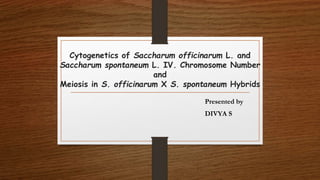
Cytogenetics of Saccharum
- 1. Cytogenetics of Saccharum officinarum L. and Saccharum spontaneum L. IV. Chromosome Number and Meiosis in S. officinarum X S. spontaneum Hybrids Presented by DIVYA S
- 2. Introduction • About variation in chromosome no of sugarcane species S. Spontaneum(2n=40, 54, 56, 64, 80, 96, 112, 120 and 128) and • About interspecific hybridization and • The chromosome numbers and meiosis of F1 hybrids between S. officinarum (2n=80) and S. spontaneum (2n=54, 56, 61, 63, 64, 80, 112, 124 and 128)
- 3. Why we are going for interspecific ? • It includes works of C.A. Barber and T.S.Venkatraman. • Initially crosses were made between local strains of S.barberi (Which is unproductive but adapted to climates of North India) and tropical noble cane (thick soft stem, high sucrose content but unsuited to climates of North India). • S.barberi X S.officinarum
- 4. • Later on by crossing these resultant hybrid with wild cane S.spontaneum ,canes with high sucrose content suitable for North India were evolved. In this way a large number of tri hybrid canes were developed. • S. barberi X S.officinarum F1 Hybrid X S.spontaneum canes with high sucrose content suitable for North India were evolved
- 5. Cultivated and wild species • Cultivated • S.officinarum - Noble cane of New guinea. ( 2n = 80) • S.barberi - North Indian canes (2n = 82 - 124 ) • S.sinensis - Chinese cane. (2n = 18) • S.edule - Melenesian cane (2n = 118) • Wild • Saccharum spontaneum (2n = 40 - 128) • S.officinarum ( 2n = 80)
- 6. Why we were specifically using S. spontaneum and S. officinarum for hybridization • Saccharum spontaneum (2n = 40 – 128) • A perennial grass, • free tillering, • often with Rhizomes • Saccharum officinarum (2n = 80) • suited to tropical conditions • stout thick • high in sucrose, low in fibre and with soft rind. • susceptible to most of the diseases.
- 7. S.officinarum – AN EXCEPTIONAL BREEDING BEHAVIOUR • NORMAL CROSS Parent A X Parent B (2n = 40) ( 2n = 20) Gametes n =20 n=10 F1 2n = 30 Parent S.officinarum X S.spontaneum 2n=80 2n = 64 Gametes 2n=80 n= 32 F1(2n =112) X S.officinarum
- 8. S.officinarum – AN EXCEPTIONAL BREEDING BEHAVIOUR • BREMER (1923) was the first to demonstrate an excess of 40 chromosomes in S. officcinarum x S. spontaneum hybrids over the expected number and concluded that these excess chromosomes were from S. officinarum. • Whole set of chromosome transmission • An exception with other species
- 9. CROSSING MATERIALS • Crosses - S. officinarum - the pistil parent (MALE STERILE NATURE) • Note : if as male parent diploid set not transfered • The chromosome numbers of S. officinarum parents were determined from root tip squashes and pollen mother cells. • In the case of S. spontaneum parents, chromosome counts from pollen mitosis as well as pollen mother cells
- 10. MEIOTIC STUDY • For the study of meiosis the inflorescence branches were fixed in Carnoy's fluid (6 absolute alcohol: 3 chloroform: 1 acetic acid saturated with ferric acetate) for 24 hours. • The materials were transferred to 70 per cent alcohol before dissecting the anthers which were squashed in aceto-carmine. • The pollen fertility was determined on stainability in one per cent aceto- carmine and glycerine (1 : 1 ).
- 11. Experimental results - • All the 20 hybrids obtained from the cross S. officinarum Chittan (2n=80) X S. spontaneum Holes (2n=54) had 2n=107 chromosomes. Chittan (2n=80) X Holes-1 (2n=54) 2n= 80 n=27 F1 ( 2n =107)
- 12. Chittan x Holes-I, metaphase-I showing 50II + 7I.
- 13. 2nd cross • S. officinarum Kaludai Boothan (2n=80) X S. spontaneum Imp 212 (2n=61) 2n= 80 n= 30 + 1I F1 (80 +30) + 1I (Disappear)
- 14. Contd., • S. officinarum Kaludai Boothan (2n=80) X S. spontaneum Imp 212 (2n=61) F1 -110 (Due to Non disjunction) ( 54II + 2 I) -110
- 15. 2nd cross • Only three hybrids were available from the cross S. officinarum Kaludai Boothan (2n=80) x S. spontaneum Imp 212 (2n=61) • All had the chromosome number of 2n= 110. 54II+2I was the maximum association observed at diakinesis as well as metaphase.
- 16. 3rd cross • The other exceptional hybrid with 11 0-chromosome from the cross Kaludai Boothan x SES. 205-A had 52 to 54 bivalents at diakinesis (mean 53.44n) with the remaining chromosomes unpaired • The chromosome association at metaphase varied from 54II (n)+2I to 51II (n)+8I
- 17. 4 th cross • From S. officinarum (2n=80) x S. spontaneum (2n = 128) crosses, both n+n (40 + 64) (KANDASAMI 1961) and 2n+n (80 + 64) (PRICE 1957, 1963) hybrids have been reported.
- 18. Meiotic behaviour of S. spontaneum • It is assumed to have contributed gametes with n = 30 to give rise to the 110-chromosome S. officinarum Kaludai Boothan x S. spontaneum • The univalent was found to be mostly eliminated at the end of the first division of meiosis and probably this results in majority of the pollen with n = 30
- 19. • S. officinarum Kaludai Boothan (2n=80) X S. spontaneum Imp 212 (2n=61) 2n= 80 n= 30 + 1I F1 (80 +30) + 1I (Disappear)
- 20. Conclusion • The present investigation has clearly shown that hybrids with chromosome numbers other than (2n+n) do occur in S. officinarum (2n=80) x S. spontaneum crosses, though to a very limited extent. • Most of such transmission of aneuploid chromosome numbers is traceable to the irregular meiotic behaviour and subsequent development of gametes with altered chromosome numbers in the parents.
- 21. • Similarly the origin of diploid gamete in S. officinarum is not clearly understood at present. According to NARAYANASWAMY • (1940) the first meiotic division of embryo-sac mother cell is normal but the diploid gamete results from the fusion of the third megaspore cell with the chalaza cell.